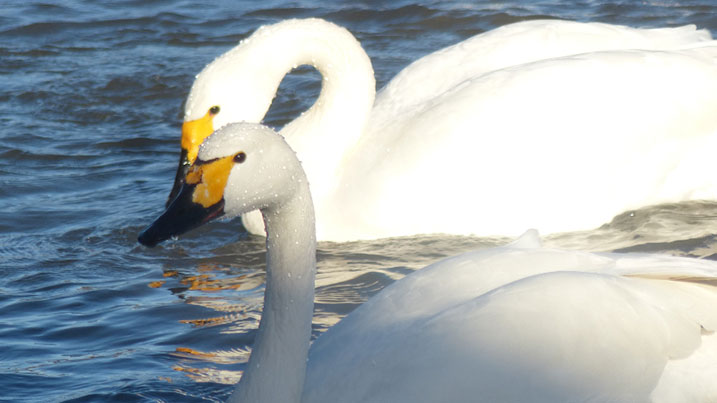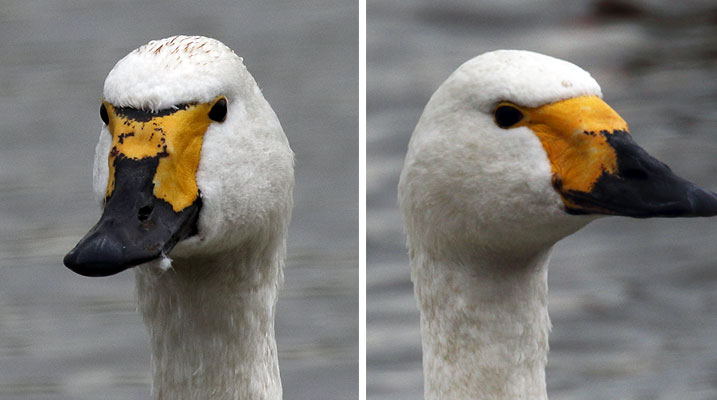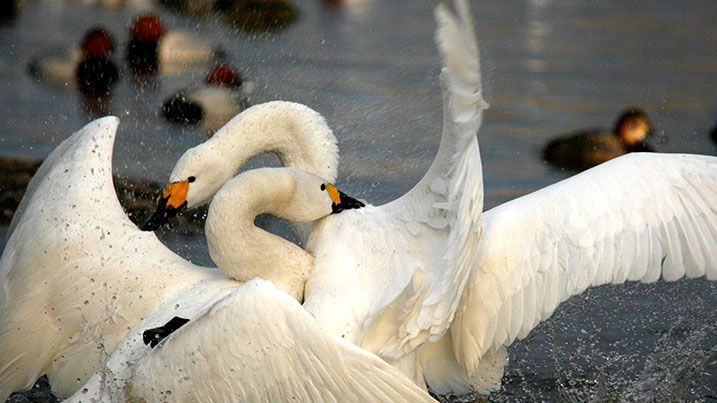Dynasties – dominance and drama on the wetlands
Some of our most successful swans belong to large dynasties, powerful families who have been returning to the same lake each year for generations. As space becomes tight, visitors to the centres are likely to witness an argument or two upon the ripples.

Beauty, grace and elegance are words that spring to mind when we think of the swan. However words such as scary, fierce, angry and hostile, are usually close behind them.
But it’s wrong to judge a cob as no more than an attractive yob. Swans rely on this aggressive instinct to battle it out with fellow competitors over the best feeding areas, prime sleeping spots, mates and personal space.
In autumn, Slimbridge’s Rushy Lake fills up with migratory birds arriving for the winter. As space becomes tight, visitors to the centre are likely to witness an argument or two upon the ripples. Some of our most successful swans belong to large dynasties, powerful families which have been returning to the same lake each year for generations. One of our most famous dynasties is The Gamblers family, led by one of our most celebrated swans, 27-year-old Croupier. They were christened by researchers who group major family lines by themed names to make them easier to remember.

Croupier’s grandparents Caroline and Nijinsky began wintering at Slimbridge in 1969. Two years later, they brought back two cygnets, one of which was Croupier's mother, Casino. Casino became a Slimbridge faithful, visiting for 26 years of her life. For many years she was the oldest bird to have ever visited the reserve, safely escorting 34 cygnets on the 2,500 mile journey from Russia to Slimbridge during her lifetime.
Why do Bewick’s swans form big family groups?
There is safety and influence in numbers. For cygnets, associating with their parents is beneficial as it offers protection from other swans and predators, and allows them to learn about feeding and roost sites. For the parents, having more cygnets around gives them more ‘clout’ in social interactions. Large family groups are dominant over small family groups, who are dominant over pairs, who in turn are dominant over singletons and so allows them to claim the best spots at feeding and roost sites.
An unhappy Bewick’s swan will approach a rival with its head lowered and call loudly, possibly also flapping its wings. If the spat escalates, the rivals will lunge, bite and peck at each other, accompanied by furious splashing. The winner will trumpet noisily, head to the sky and wings waving in triumph – and the fuss is all over.

How aggressive are swans?
Although quarrelling swans can be an unsettling sight, most of it is posturing. Despite their bad rap, swans are no more hostile than any other water bird and the majority of fights are won without resorting to avian violence. In fact research suggests that swans are just as aggro as other wetland birds. The study, involving 555 birds from 64 different species and published in the scientific journal Animal Behaviour, discovered that males were more aggressive than females and adults more belligerent than youngsters. It has nothing to do with species. The phrase ‘mad as a coot’ wasn’t coined for nothing.
WWT’s Principal Research Officer Dr Kevin Wood led the study. He explained:
When it comes to aggression, it’s less about what species the offending bird is, and more about whether it’s adult or male. “If you wander around WWT’s headquarters at Slimbridge, you’ll see coots warring with anything that moves, and greylag geese hissing at anything nearby. They’re all at it. These are natural behaviours. For the birds it’s a way of trying to ensure that they and their family do well in life.
So the next time you’re visiting Slimbridge and you catch Bewick’s mid-barney, you’re witnessing a bird trying to secure the best for themselves and their families, aggression being a key feature to the survival of the beautiful, graceful, elegant swan.



